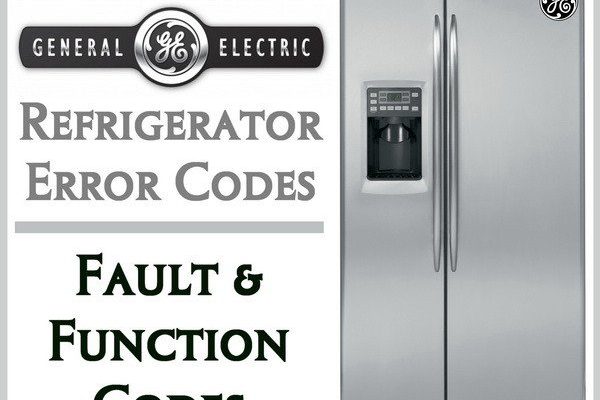
Picture your refrigerator as a sophisticated team, each component having its own important role. The error code OE is like your fridge’s way of waving a red flag, signaling that the team isn’t functioning as it should. Understanding what OE means and how to tackle it can save you time, stress, and potentially even money. We’ll walk you through some straightforward strategies to prevent this error, ensuring your fridge stays in top shape and keeps your food fresh.
Understanding Error Code OE and Its Causes
First things first, let’s dive into what error code OE actually means. This code typically points to an issue with water overflow, which is like having a tiny river flowing where it shouldn’t inside your fridge. Now you might be wondering, “How does this happen?” Well, just like a clogged gutter can lead to a flooded yard, a blocked drain or a malfunctioning water inlet valve in your fridge can cause excess water to accumulate.
One common culprit is a blocked defrost drain. When ice melts during the defrost cycle, the water is supposed to trickle down the drain into a pan underneath the fridge. But if this drain is blocked by debris, food particles, or even ice, water backs up, creating an overflow problem. Another reason could be a faulty water inlet valve—think of it as a faucet that won’t shut off, leading to continuous water flow.
Lastly, the door seals play a crucial role. If they’re not sealing properly, warm air can sneak into your fridge, causing more ice to form, which eventually overwhelms the defrost system. Just like a drafty window lets cold air escape from your house, faulty seals let in warm air that can cause chaos in your fridge’s delicate balance.
Here’s what you can do: Regularly check and clean the defrost drain, ensure the water inlet valve is functioning correctly, and inspect your door seals for any signs of wear or gaps.
Maintaining the Defrost Drain: A Simple Habit
To keep your fridge in top condition, one of the simplest and most effective steps is maintaining a clear defrost drain. Think of it as brushing your teeth—routine maintenance can prevent a world of trouble later on. The defrost drain is like a tiny gutter, carrying away excess water. If it clogs, you end up with a splash of water inside your fridge.
Start by locating the drain, usually found at the back or bottom of the fridge compartment. If you notice water pooling around it or reduced cooling efficiency, it’s time for action. A DIY method involves using a turkey baster or a similar tool to flush warm water through the drain to dislodge any clogs. It’s quick, easy, and can save you from more serious issues.
Furthermore, consider setting a reminder every few months to check the drain. Look for any signs of blockage and clean it as necessary. This simple habit can significantly reduce the chances of encountering the OE error, keeping your fridge running smoothly and your food safe.
Water Inlet Valve: The Unsung Hero
Let’s shift our focus to another component—the water inlet valve. Imagine it as the gatekeeper of water flow into your fridge. If this valve doesn’t close properly, it’s like a dripping faucet that eventually floods the kitchen. Addressing issues with this valve can help prevent overflow problems that trigger the OE error.
Regular inspections can make a big difference. If you ever hear strange noises or notice excessive moisture buildup, it might be worth examining the valve. Sometimes, mineral buildup from hard water can interfere with its operation, so a good cleaning or replacement might be in order. This is your fridge’s way of whispering, “Help me help you.”
If you’re hesitant, you can always call a professional. But knowing how to identify potential valve issues can empower you to make informed decisions. Remember, maintaining the water inlet valve can be a proactive way to keep your fridge functioning without a hitch.
Keeping an Eye on Door Seals
Now, let’s not forget the door seals—those trusty rubber gaskets that keep cool air in and warm air out. Think of them as the fridge’s protective barrier, much like a well-fitting scarf keeps you warm in the winter. If these seals are compromised, your fridge has to work overtime, which can exacerbate issues like the OE error.
Regularly inspect the seals by feeling for any drafts or visually checking for cracks and tears. For a quick test, close the fridge door on a piece of paper; if it slides out easily, the seal might need some TLC. Worn seals let in warm air, which can mess with the fridge’s internal temperature, causing excess condensation and potential overflows.
Replacement seals are readily available and can often be installed with minimal fuss. Keep an eye out for any signs of wear, and don’t hesitate to replace them if necessary. Properly maintained seals not only help prevent the OE error but also ensure your fridge runs efficiently, keeping your food fresh and your energy bills lower.
Final Thoughts and Preventative Tips
By now, you’ve got a solid grasp on how to tackle the OE error like a pro. To wrap things up, let’s look at some preventative measures. Just like regular exercise keeps your body healthy, a little routine maintenance can keep your fridge in perfect working order. Regularly clean the defrost drain, inspect and maintain the water inlet valve, and check those door seals to ensure they’re up to the task.
Incorporating these habits into your routine can seem daunting at first, but they quickly become second nature. Before you know it, your fridge will be running smoothly, providing you with cool, fresh food without any drama. Remember, a little effort today can save you a whole lot of hassle tomorrow.
So there you have it—your guide to preventing the GE refrigerator error code OE. Keep this knowledge close, and your fridge will thank you with years of reliable service. Happy refrigerating!
